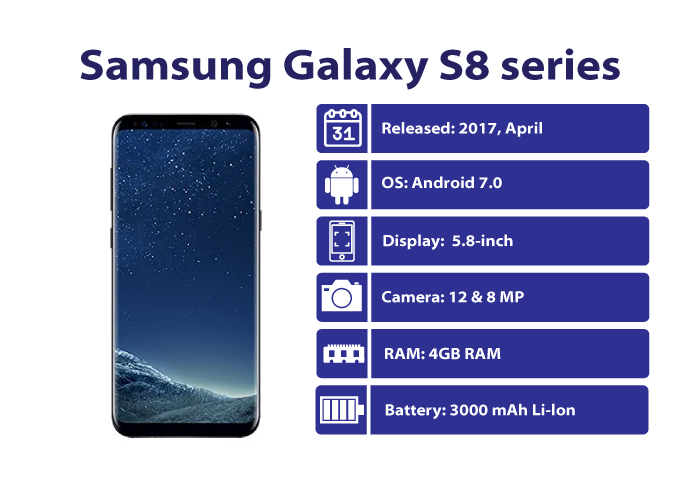The Samsung Galaxy S8 series, comprising the Galaxy S8 and Galaxy S8+, was released in April 2017, representing a significant leap forward in smartphone design, display technology, and features. Here’s a comprehensive review of the Samsung Galaxy S8 series:
Design: The Galaxy S8 series introduced a radical new design language with the “Infinity Display,” featuring minimal bezels and curved edges that seamlessly blended into the metal frame. The result was a stunning, bezel-less front that maximized the screen-to-body ratio and provided an immersive viewing experience. Both the Galaxy S8 and S8+ featured glass backs and metal frames, giving them a premium look and feel.
Display: The highlight of the Galaxy S8 series was its stunning display. The Galaxy S8 featured a 5.8-inch Quad HD+ Super AMOLED display, while the Galaxy S8+ boasted a larger 6.2-inch display, both with a resolution of 2960 x 1440 pixels. The Infinity Display offered vibrant colors, deep blacks, and excellent viewing angles, making it ideal for multimedia consumption, gaming, and productivity tasks.
Performance: Powered by a Qualcomm Snapdragon 835 or Exynos 8895 processor (depending on the region) and 4GB of RAM, the Galaxy S8 series delivered powerful and responsive performance. The devices handled multitasking, gaming, and productivity tasks with ease, providing a smooth user experience. The combination of powerful hardware and Samsung’s optimized software ensured fast app launch times and fluid animations.
Camera: The Galaxy S8 series featured a 12-megapixel rear camera with Dual Pixel technology and optical image stabilization (OIS), capable of capturing detailed photos with accurate colors and good dynamic range. The camera performed well in various lighting conditions, and features like Pro mode and selective focus provided advanced control over settings. The front-facing camera was 8 megapixels and delivered quality selfies and video calls.
Battery: The Galaxy S8 housed a 3000mAh battery, while the Galaxy S8+ featured a larger 3500mAh battery. Both devices offered all-day battery life for most users, with the Galaxy S8+ lasting longer due to its larger battery capacity. Both devices supported fast charging and wireless charging, providing convenient ways to recharge the battery quickly.
Software: At launch, the Galaxy S8 series ran Android 7.0 Nougat with Samsung’s TouchWiz user interface on top. The devices received subsequent updates to newer versions of Android, along with security patches and feature enhancements. Samsung’s software experience included features like Bixby virtual assistant, Samsung DeX for desktop-like productivity, and Knox security for enterprise users.
Features: Additional features of the Galaxy S8 series included an iris scanner and facial recognition for biometric authentication, Samsung Pay for mobile payments, IP68 water and dust resistance, and an always-on display for quick access to notifications and information.
Conclusion: The Samsung Galaxy S8 series was a groundbreaking lineup of smartphones that pushed the boundaries of design and technology. With its stunning Infinity Display, powerful performance, and innovative features, the Galaxy S8 series set a new standard for flagship smartphones. Despite being several years old, the Galaxy S8 series remained a compelling choice for users looking for a premium smartphone experience.



1 Comment
Very interesting info!Perfect just what I was searching for!Blog monry